

Compact Muon Solenoid
LHC, CERN
| CMS-PAS-B2G-24-015 | ||
| Search for resonances decaying to a Higgs boson in the bb final state and an anomalous jet | ||
| CMS Collaboration | ||
| 28 March 2025 | ||
| Abstract: This note presents an analysis searching for new physics through the process where a new massive particle, X, decays into a Higgs boson and a second particle, Y. The Higgs boson subsequently decays into a pair of b-quarks and the decay products of Y are assumed to produce a non-QCD-like, e.g. anomalous, jet. In the benchmark process, Y decays into W+W− forming one large-area jet. A second benchmark process is also considered, where Y is a hadronically decaying top quark, originating from a vector-like quark decaying into a top quark and a Higgs boson. CMS data recorded at a centre-of-mass energy of 13 TeV in 2016-2018 and corresponding to 138 fb−1 are analysed. In this analysis, the identification of the Y particle is enhanced by computing the anomaly score of its candidate jet using an autoencoder, allowing the simultaneous search for multiple Y decay modes with a single analysis. No significant excesses are observed and upper limits on the signal cross section for various masses of X and Y, at 95% confidence level, are placed. | ||
| Links: CDS record (PDF) ; CADI line (restricted) ; | ||
| Figures | |
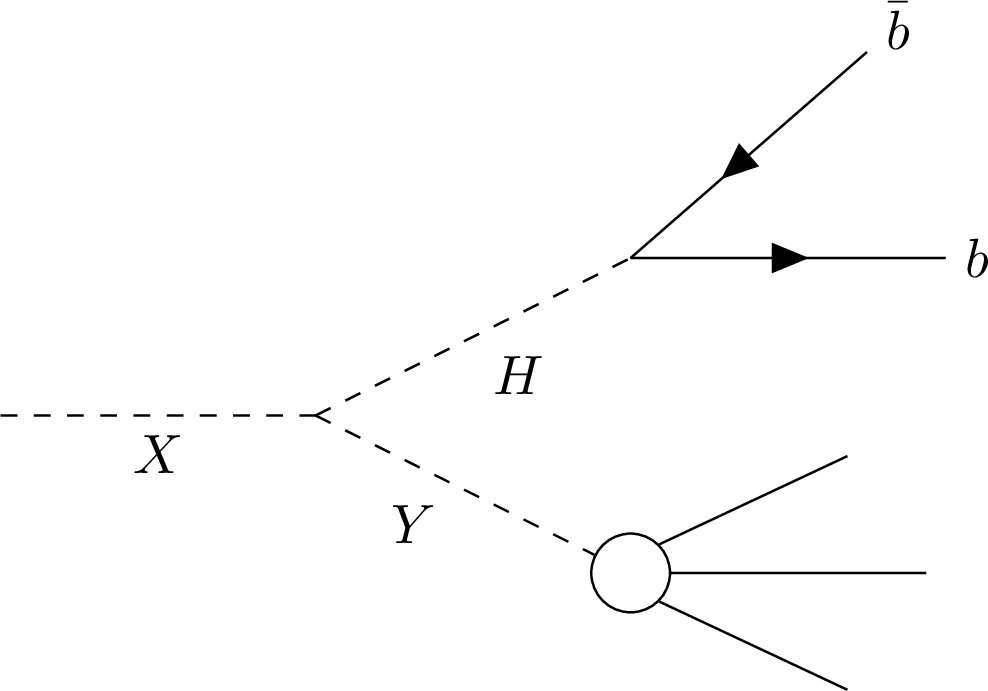
png pdf |
Figure 1:
An illustration showing the signal targeted by this analysis. The final state consists of a boosted jet originated from H decaying to b¯b and another boosted jet originating from the decay of a second particle, Y. |
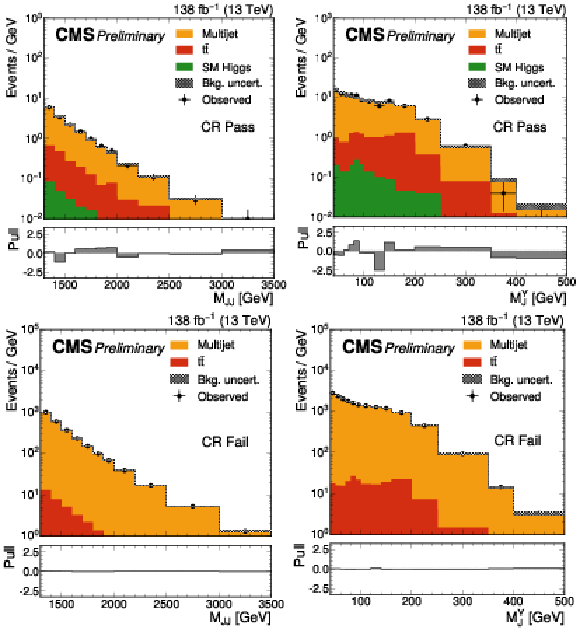
png pdf |
Figure 2:
The Mjj (left) and MYj (right) projections for the number of observed events (black markers) compared with the backgrounds estimated in the fit to the data (filled histograms) in the CR. Pass (upper) and fail (lower) control region categories are shown. The high level of agreement between the model and the data in the fail region is due to the nature of the background estimate. The lower panels show the ``Pull'' defined as (observed events−expected events) /√σ2obs+σ2exp, where σobs and σexp are the total uncertainties in the observation and the background estimation, respectively. |
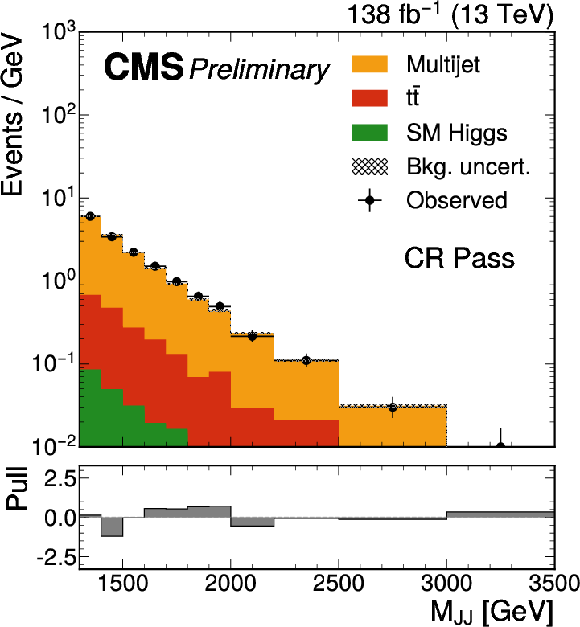
png pdf |
Figure 2-a:
The Mjj (left) and MYj (right) projections for the number of observed events (black markers) compared with the backgrounds estimated in the fit to the data (filled histograms) in the CR. Pass (upper) and fail (lower) control region categories are shown. The high level of agreement between the model and the data in the fail region is due to the nature of the background estimate. The lower panels show the ``Pull'' defined as (observed events−expected events) /√σ2obs+σ2exp, where σobs and σexp are the total uncertainties in the observation and the background estimation, respectively. |
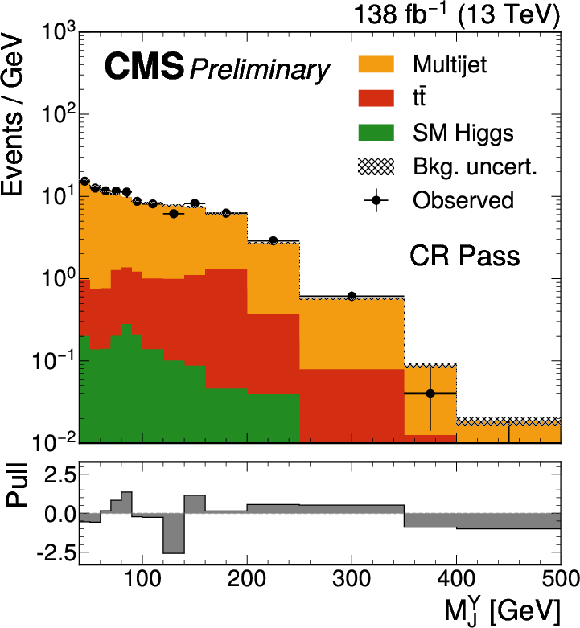
png pdf |
Figure 2-b:
The Mjj (left) and MYj (right) projections for the number of observed events (black markers) compared with the backgrounds estimated in the fit to the data (filled histograms) in the CR. Pass (upper) and fail (lower) control region categories are shown. The high level of agreement between the model and the data in the fail region is due to the nature of the background estimate. The lower panels show the ``Pull'' defined as (observed events−expected events) /√σ2obs+σ2exp, where σobs and σexp are the total uncertainties in the observation and the background estimation, respectively. |
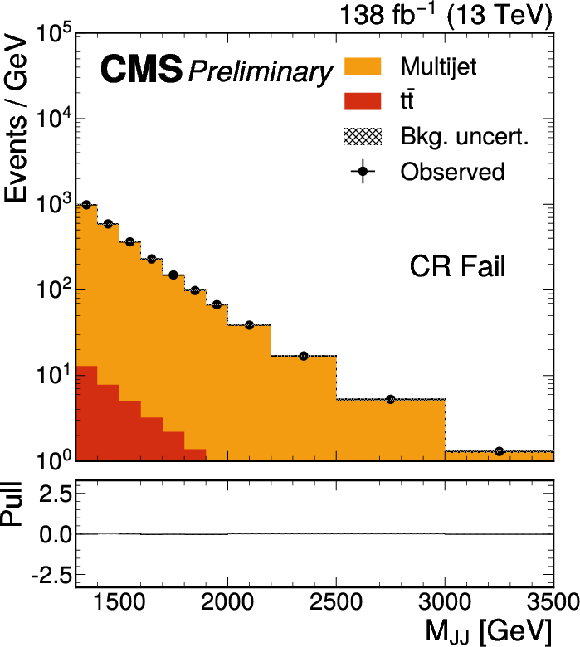
png pdf |
Figure 2-c:
The Mjj (left) and MYj (right) projections for the number of observed events (black markers) compared with the backgrounds estimated in the fit to the data (filled histograms) in the CR. Pass (upper) and fail (lower) control region categories are shown. The high level of agreement between the model and the data in the fail region is due to the nature of the background estimate. The lower panels show the ``Pull'' defined as (observed events−expected events) /√σ2obs+σ2exp, where σobs and σexp are the total uncertainties in the observation and the background estimation, respectively. |
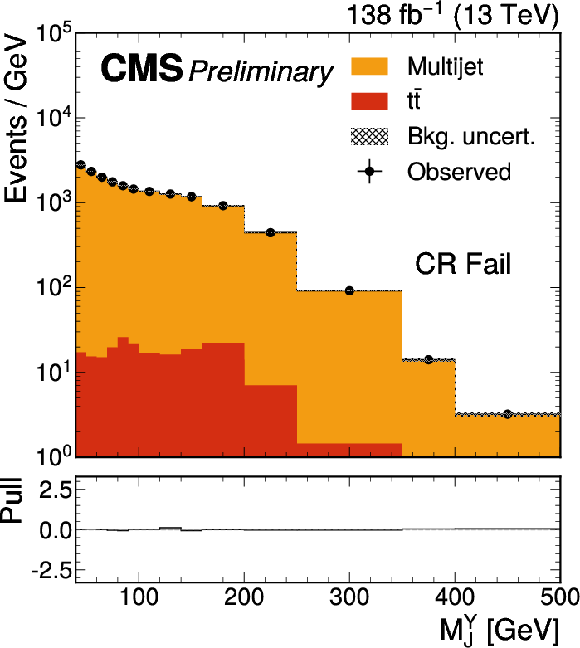
png pdf |
Figure 2-d:
The Mjj (left) and MYj (right) projections for the number of observed events (black markers) compared with the backgrounds estimated in the fit to the data (filled histograms) in the CR. Pass (upper) and fail (lower) control region categories are shown. The high level of agreement between the model and the data in the fail region is due to the nature of the background estimate. The lower panels show the ``Pull'' defined as (observed events−expected events) /√σ2obs+σ2exp, where σobs and σexp are the total uncertainties in the observation and the background estimation, respectively. |

png pdf |
Figure 3:
The Mjj (left) and MYj (right) projections for the number of observed events (black markers) compared with the backgrounds estimated in the fit to the data (filled histograms) in the SR. Pass (upper) and fail (lower) control region categories are shown. The high level of agreement between the model and the data in the fail region is due to the nature of the background estimate. |
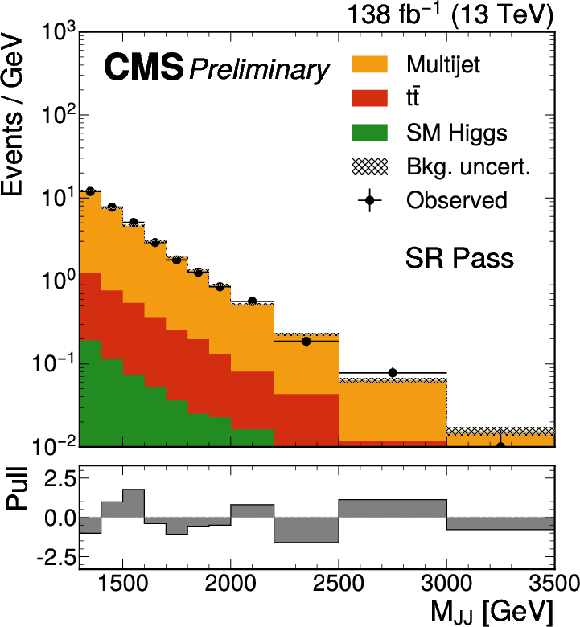
png pdf |
Figure 3-a:
The Mjj (left) and MYj (right) projections for the number of observed events (black markers) compared with the backgrounds estimated in the fit to the data (filled histograms) in the SR. Pass (upper) and fail (lower) control region categories are shown. The high level of agreement between the model and the data in the fail region is due to the nature of the background estimate. |
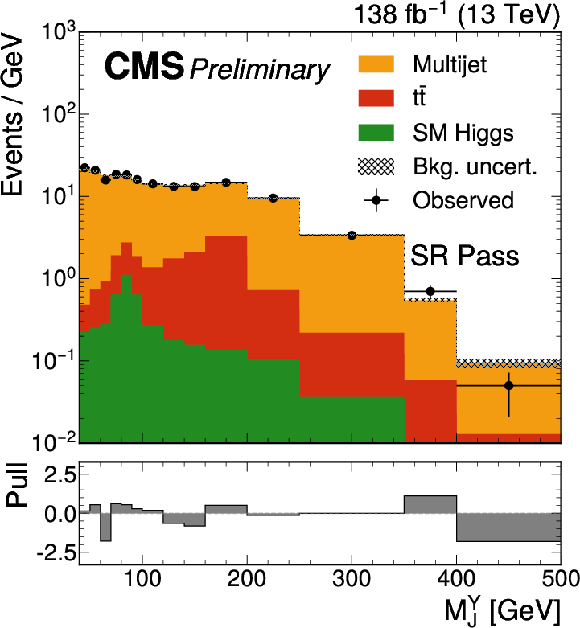
png pdf |
Figure 3-b:
The Mjj (left) and MYj (right) projections for the number of observed events (black markers) compared with the backgrounds estimated in the fit to the data (filled histograms) in the SR. Pass (upper) and fail (lower) control region categories are shown. The high level of agreement between the model and the data in the fail region is due to the nature of the background estimate. |
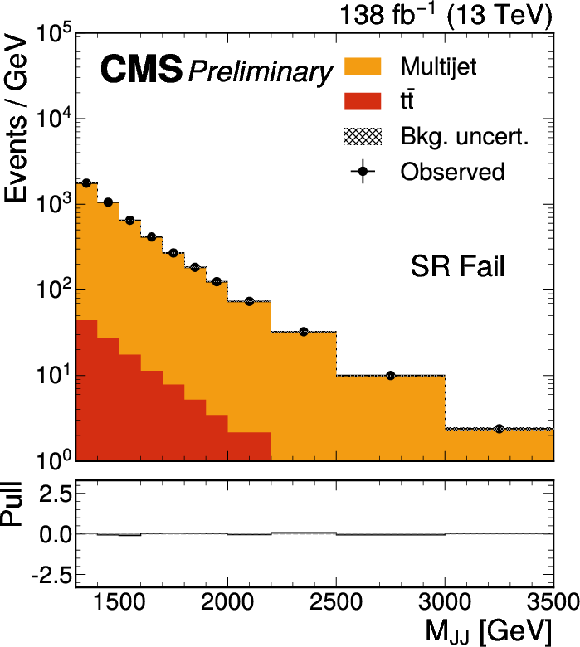
png pdf |
Figure 3-c:
The Mjj (left) and MYj (right) projections for the number of observed events (black markers) compared with the backgrounds estimated in the fit to the data (filled histograms) in the SR. Pass (upper) and fail (lower) control region categories are shown. The high level of agreement between the model and the data in the fail region is due to the nature of the background estimate. |
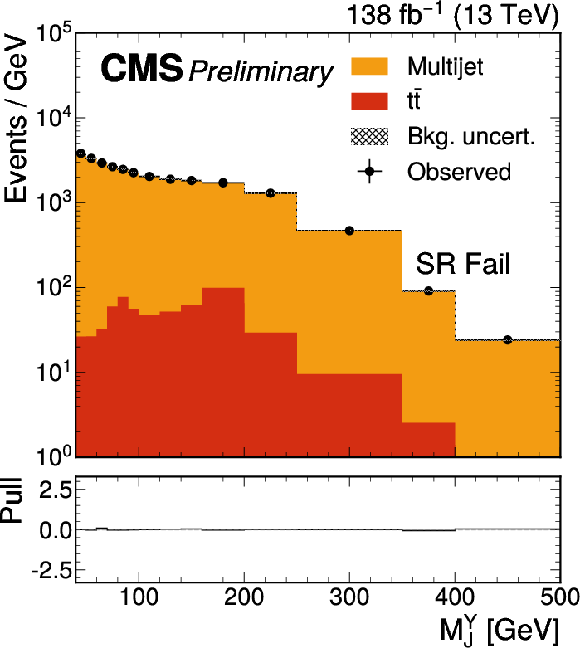
png pdf |
Figure 3-d:
The Mjj (left) and MYj (right) projections for the number of observed events (black markers) compared with the backgrounds estimated in the fit to the data (filled histograms) in the SR. Pass (upper) and fail (lower) control region categories are shown. The high level of agreement between the model and the data in the fail region is due to the nature of the background estimate. |

png pdf |
Figure 4:
The expected (upper) and observed (lower) 95% confidence level upper limits on σ(pp→X→(H→b¯b)(Y→WW→4q)) for different values of MX and MY. The limits have been evaluated in discrete steps corresponding to the centers of the boxes. The numbers in the boxes are given in fb. |
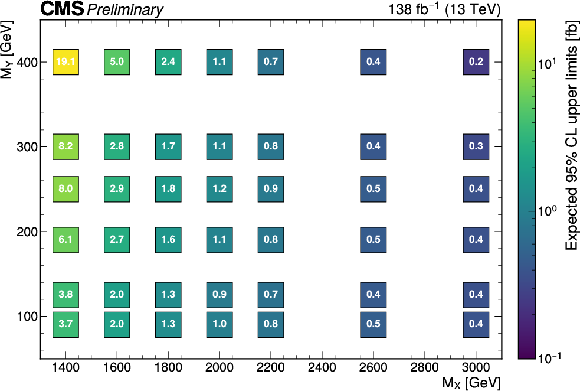
png pdf |
Figure 4-a:
The expected (upper) and observed (lower) 95% confidence level upper limits on σ(pp→X→(H→b¯b)(Y→WW→4q)) for different values of MX and MY. The limits have been evaluated in discrete steps corresponding to the centers of the boxes. The numbers in the boxes are given in fb. |
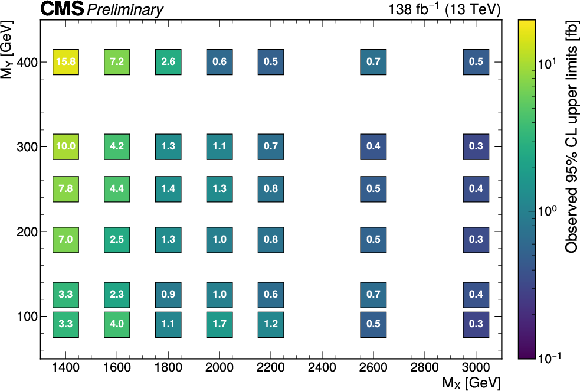
png pdf |
Figure 4-b:
The expected (upper) and observed (lower) 95% confidence level upper limits on σ(pp→X→(H→b¯b)(Y→WW→4q)) for different values of MX and MY. The limits have been evaluated in discrete steps corresponding to the centers of the boxes. The numbers in the boxes are given in fb. |
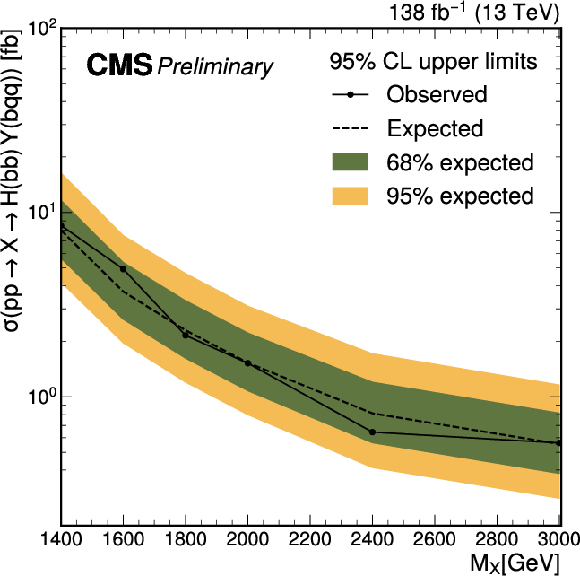
png pdf |
Figure 5:
The median expected (dashed line) and observed (solid line) 95% confidence level upper limits on σ(pp→X→(H→b¯b)(Y→bq¯q)) for different values of MX. The inner (green) band and the outer (yellow) band indicate the regions containing 68% and 95%, respectively, of the distribution of limits expected under the background-only hypothesis. |
| Summary |
| A search for new physics through the process where a resonant particle decays into a Higgs boson and an additional particle Y is presented. The Higgs boson subsequently decays into a pair of b-quarks, and both resultant particles are reconstructed as large-area jets in the Lorentz-boosted regime. H candidate jets are tagged using the ParticleNet tagger that is designed to recognize jets originating from a decay of a massive particle into b¯b. The identification of the second particle is enhanced by computing the anomaly score of its candidate jet using an autoencoder, allowing the simultaneous search for multiple Y decay modes with a single analysis. The analysis considers two benchmark models. The main benchmark assumes Y→W+W−, with further hadronic decays of the W bosons. It is simulated for 42 different MX and MY hypotheses. The largest local significance of 2.06 σ is observed for MX= 1600 GeV and MY= 90 GeV, with a p value of 0.019. This corresponds to a global significance of 0.13 σ after accounting for the look-elsewhere effect. Exclusion limits, at 95% confidence level, are set in the 0.3--16 fb range, depending on the mass hypothesis. Exclusion limits are also placed on a second benchmark that assumes the Y→bq¯q decay mode, originating from a vector-like quark decaying into a top quark and a Higgs boson, with MX ranging from 1400 to 3000 GeV while MY is set to the mass of the top quark. |
| References | ||||
| 1 | Particle Data Group Collaboration | Review of particle physics | PRD 110 (2024) 030001 | |
| 2 | Planck Collaboration | Planck 2013 results. I. Overview of products and scientific results | Astron. Astrophys. 571 (2014) | 1303.5062 |
| 3 | M. Dine and A. Kusenko | Origin of the matter-antimatter asymmetry | Rev. Mod. Phys. 76 (2003) | hep-ph/0303065 |
| 4 | P. Fayet | Supergauge invariant extension of the Higgs mechanism and a model for the electron and its neutrino | NPB 90 (1975) 104 | |
| 5 | P. Fayet | Spontaneously broken supersymmetric theories of weak, electromagnetic and strong interactions | PLB 69 (1977) 489 | |
| 6 | L. Randall and R. Sundrum | A large mass hierarchy from a small extra dimension | PRL 83 (1999) 3370 | hep-ph/9905221 |
| 7 | L. Randall and R. Sundrum | An Alternative to compactification | PRL 83 (1999) 4690 | hep-th/9906064 |
| 8 | T. Robens, T. Stefaniak, and J. Wittbrodt | Two-real-scalar-singlet extension of the SM: LHC phenomenology and benchmark scenarios | EPJC 80 (2020) 151 | 1908.08554 |
| 9 | U. Ellwanger, C. Hugonie, and A. M. Teixeira | The next-to-minimal supersymmetric standard model | Phys. Rept. 496 (2010) 1 | 0910.1785 |
| 10 | CMS Collaboration | Searches for Higgs boson production through decays of heavy resonances | Phys. Rept. 1115 (2025) 368 | 2403.16926 |
| 11 | A. Carvalho et al. | Single production of vectorlike quarks with large width at the large hadron collider | Physical Review D 98 (2018) | 1805.06402 |
| 12 | G. Kasieczka et al. | The LHC olympics 2020: A community challenge for anomaly detection in high energy physics | Rept. Prog. Phys. 84 (2021) 124201 | 2101.08320 |
| 13 | CMS Collaboration | Model-agnostic search for dijet resonances with anomalous jet substructure in proton-proton collisions at √s = 13 TeV | CMS Physics Analysis Summary, 2024 CMS-PAS-EXO-22-026 |
CMS-PAS-EXO-22-026 |
| 14 | CMS Collaboration | Identification of highly Lorentz-boosted heavy particles using graph neural networks and new mass decorrelation techniques | CMS Detector Performance Summary CMS-DP-2020-002, 2020 CDS |
|
| 15 | CMS Collaboration | The CMS experiment at the CERN LHC | JINST 3 (2008) S08004 | |
| 16 | CMS Collaboration | Development of the CMS detector for the CERN LHC Run 3 | JINST 19 (2024) P05064 | CMS-PRF-21-001 2309.05466 |
| 17 | CMS Collaboration | Performance of the CMS Level-1 trigger in proton-proton collisions at √s= 13\,TeV | JINST 15 (2020) P10017 | CMS-TRG-17-001 2006.10165 |
| 18 | CMS Collaboration | The CMS trigger system | JINST 12 (2017) P01020 | CMS-TRG-12-001 1609.02366 |
| 19 | CMS Collaboration | Performance of the CMS high-level trigger during LHC Run 2 | JINST 19 (2024) P11021 | CMS-TRG-19-001 2410.17038 |
| 20 | CMS Collaboration | Electron and photon reconstruction and identification with the CMS experiment at the CERN LHC | JINST 16 (2021) P05014 | CMS-EGM-17-001 2012.06888 |
| 21 | CMS Collaboration | Performance of the CMS muon detector and muon reconstruction with proton-proton collisions at √s= 13 TeV | JINST 13 (2018) P06015 | CMS-MUO-16-001 1804.04528 |
| 22 | CMS Collaboration | Description and performance of track and primary-vertex reconstruction with the CMS tracker | JINST 9 (2014) P10009 | CMS-TRK-11-001 1405.6569 |
| 23 | CMS Collaboration | Particle-flow reconstruction and global event description with the CMS detector | JINST 12 (2017) P10003 | CMS-PRF-14-001 1706.04965 |
| 24 | M. Cacciari, G. P. Salam, and G. Soyez | The anti-kT jet clustering algorithm | JHEP 04 (2008) 063 | 0802.1189 |
| 25 | M. Cacciari, G. P. Salam, and G. Soyez | FastJet user manual | EPJC 72 (2012) 1896 | 1111.6097 |
| 26 | CMS Collaboration | Pileup mitigation at CMS in 13 TeV data | JINST 15 (2020) P09018 | CMS-JME-18-001 2003.00503 |
| 27 | D. Bertolini, P. Harris, M. Low, and N. Tran | Pileup per particle identification | JHEP 10 (2014) 059 | 1407.6013 |
| 28 | G. P. Salam | Towards jetography | EPJC 67 (2010) 637 | 0906.1833 |
| 29 | M. Dasgupta, A. Fregoso, S. Marzani, and G. P. Salam | Towards an understanding of jet substructure | JHEP 09 (2013) 029 | 1307.0007 |
| 30 | A. J. Larkoski, S. Marzani, G. Soyez, and J. Thaler | Soft drop | JHEP 05 (2014) 146 | 1402.2657 |
| 31 | J. Alwall et al. | The automated computation of tree-level and next-to-leading order differential cross sections, and their matching to parton shower simulations | JHEP 07 (2014) 079 | 1405.0301 |
| 32 | D. Curtin et al. | Exotic decays of the 125 GeV Higgs boson | PRD 90 (2014) 075004 | 1312.4992 |
| 33 | A. Alloul et al. | FeynRules 2.0 --- a complete toolbox for tree-level phenomenology | Comput. Phys. Commun. 185 (2014) 2250 | 1310.1921 |
| 34 | S. Frixione, G. Ridolfi, and P. Nason | A positive-weight next-to-leading-order Monte Carlo for heavy flavour hadroproduction | JHEP 09 (2007) 126 | 0707.3088 |
| 35 | S. Frixione, P. Nason, and C. Oleari | Matching NLO QCD computations with parton shower simulations: the POWHEG method | JHEP 11 (2007) 070 | 0709.2092 |
| 36 | S. Alioli, P. Nason, C. Oleari, and E. Re | A general framework for implementing NLO calculations in shower Monte Carlo programs: the POWHEG BOX | JHEP 06 (2010) 043 | 1002.2581 |
| 37 | P. Nason | A new method for combining NLO QCD with shower monte carlo algorithms | JHEP 11 (2004) 040 | hep-ph/0409146 |
| 38 | M. Czakon and A. Mitov | Top++: A program for the calculation of the top-pair cross-section at hadron colliders | Comput. Phys. Commun. 185 (2014) 2930 | 1112.5675 |
| 39 | P. F. Monni et al. | MiNNLOPS: a new method to match NNLO QCD to parton showers | JHEP 05 (2020) 143 | 1908.06987 |
| 40 | P. F. Monni, E. Re, and M. Wiesemann | MiNNLOPS: optimizing 2 → 1 hadronic processes | EPJC 80 (2020) 1075 | 2006.04133 |
| 41 | P. Nason and C. Oleari | NLO Higgs boson production via vector-boson fusion matched with shower in POWHEG | JHEP 02 (2010) 037 | 0911.5299 |
| 42 | G. Luisoni, P. Nason, C. Oleari, and F. Tramontano | HW±/HZ+0 and 1 jet at NLO with the POWHEG box interfaced to GoSam and their merging within MiNLO | JHEP 10 (2013) 083 | 1306.2542 |
| 43 | NNPDF Collaboration | Parton distributions from high-precision collider data | EPJC 77 (2017) 663 | 1706.00428 |
| 44 | A. Buckley et al. | LHAPDF6: parton density access in the LHC precision era | EPJC 75 (2015) 132 | 1412.7420 |
| 45 | CMS Collaboration | Extraction and validation of a new set of CMS PYTHIA8 tunes from underlying-event measurements | EPJC 80 (2020) 4 | CMS-GEN-17-001 1903.12179 |
| 46 | J. Allison et al. | GEANT 4 developments and applications | IEEE Trans. Nucl. Sci. 53 (2006) 270 | |
| 47 | CMS Collaboration | Measurement of the inelastic proton-proton cross section at √s= 13 TeV | JHEP 07 (2018) 161 | CMS-FSQ-15-005 1802.02613 |
| 48 | D. P. Kingma and M. Welling | Auto-encoding variational bayes | \url https://arxiv.org/abs/1312.6114, 2022 link |
|
| 49 | CMS Collaboration | Lund Plane Reweighting for Jet Substructure Correction | CMS Detector Performance Summary CMS-DP-2023-046, 2023 CDS |
|
| 50 | R. G. Lomax and D. L. Hahs | Statistical concepts: a second course | -Vaughn, . Taylor and Francis, 2012 | |
| 51 | CMS Collaboration | Precision luminosity measurement in proton-proton collisions at √s= 13 TeV in 2015 and 2016 at CMS | EPJC 81 (2021) 800 | CMS-LUM-17-003 2104.01927 |
| 52 | CMS Collaboration | CMS luminosity measurement for the 2017 data-taking period at √s = 13 TeV | CMS Physics Analysis Summary, 2018 link |
CMS-PAS-LUM-17-004 |
| 53 | CMS Collaboration | CMS luminosity measurement for the 2018 data-taking period at √s = 13 TeV | CMS Physics Analysis Summary, 2019 link |
CMS-PAS-LUM-18-002 |
| 54 | CMS Collaboration | The CMS statistical analysis and combination tool: COMBINE | Comput. Softw. Big Sci. 8 (2024) 19 | CMS-CAT-23-001 2404.06614 |
| 55 | A. L. Read | Presentation of search results: the CLs technique | JPG 28 (2002) 2693 | |
| 56 | T. Junk | Confidence level computation for combining searches with small statistics | NIM A 434 (1999) 435 | hep-ex/9902006 |
| 57 | G. Cowan, K. Cranmer, E. Gross, and O. Vitells | Asymptotic formulae for likelihood-based tests of new physics | EPJC 71 (2011) 1554 | 1007.1727 |

|
Compact Muon Solenoid LHC, CERN |

|

|

|

|

|

|